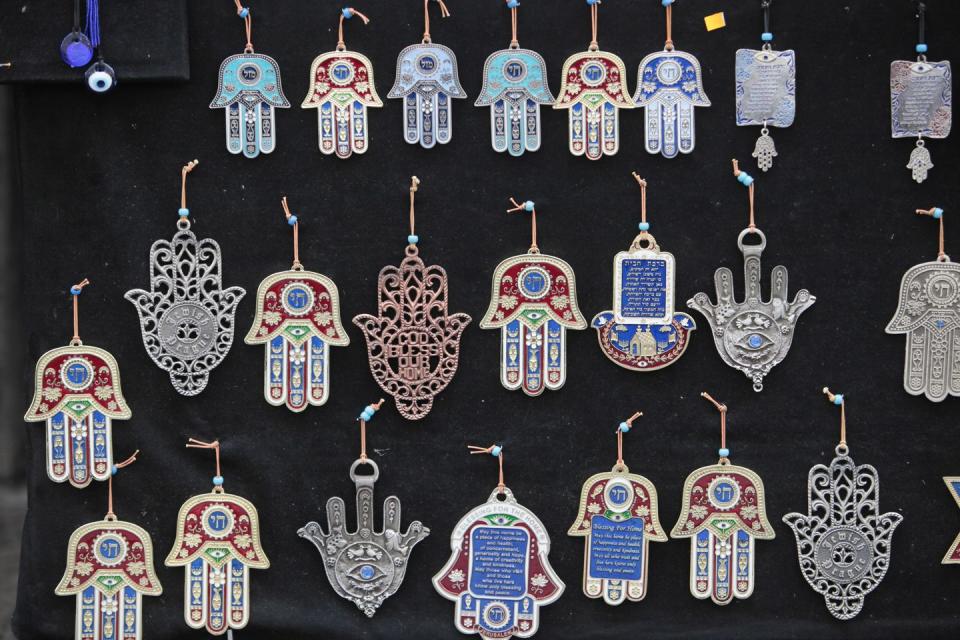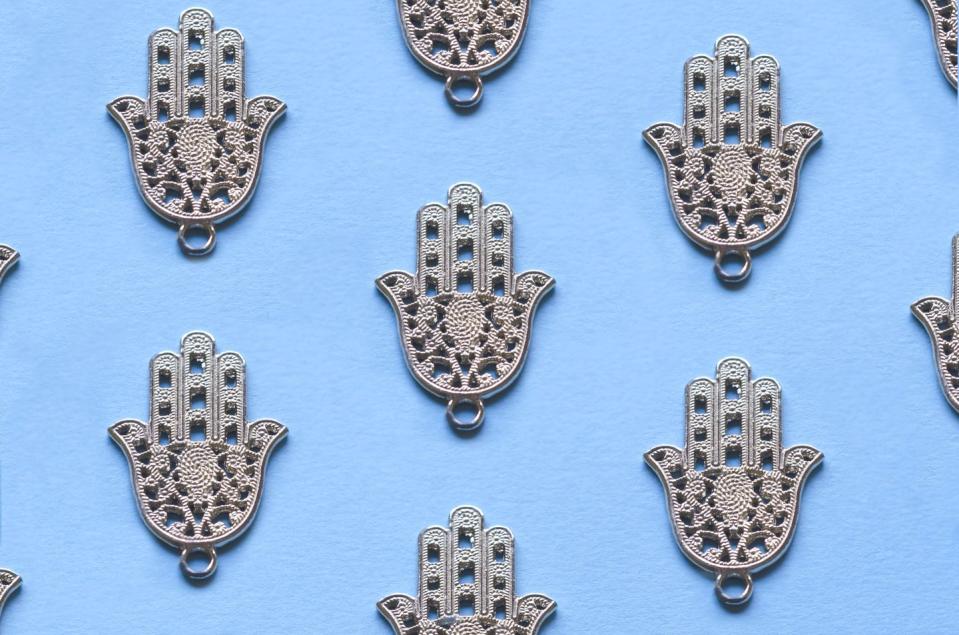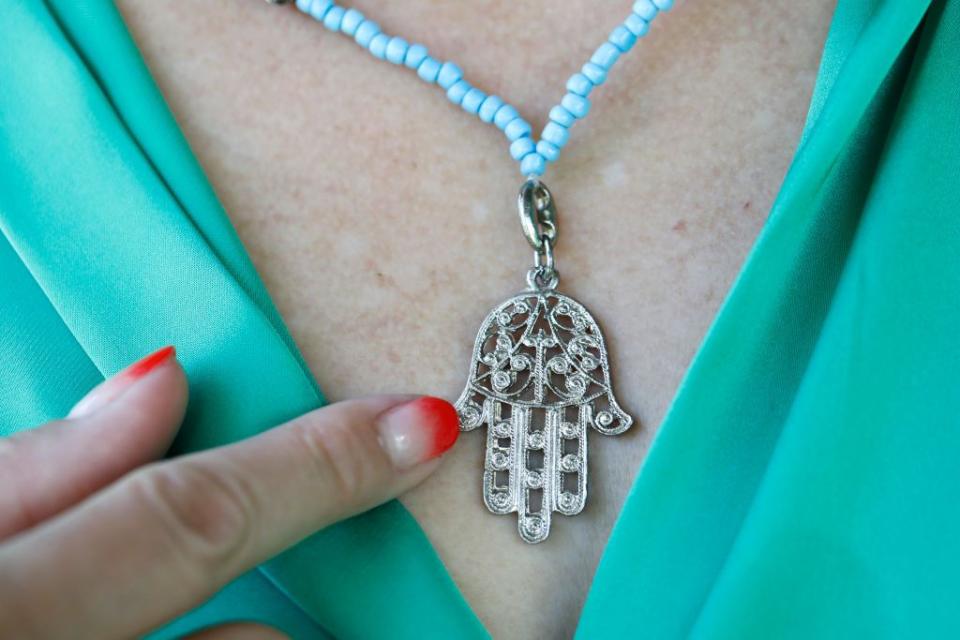The Deeper Meaning Behind the Hamsa Hand, According to Spiritual Experts
[table-of-contents] stripped
You've probably seen them around just about everywhere: the symbol of a hand with an eye at the center rendered in jewelry, home decor, serving pieces, tattoos, keychains, and more. But what actually is it?
That five-fingered hand is an ancient symbol called a hamsa, and the hamsa meaning has been powerful across many cultures and religions for thousands of years.
“A hamsa is an amulet — a good luck symbol that is embraced by many different religious traditions,” explains Rabbi Dr. Jo David, who has a Doctor of Ministry degree in Multifaith Ministry from New York Theological Seminary. “It is an object that one might wear or one might display in one’s home to encourage every kind of good luck.”
Rabbi David explains that the hamsa, which resembles an open palm, is “associated with the power of the female.” It’s generally regarded as a symbol of protection, often considered a symbol of the hand of god by people of faith but also considered a pagan fertility symbol. Any spiritual person can employ it for a feeling of connection to fortuitous energy and outcomes, as well as a sense of protection.

Read on to discover more about the history, origins, and meaning of the hamsa across Christianity, Islam, and Judaism, plus how you can use it in your own life.
What is the Hamsa?
The shape of a hamsa is a five-fingered hand. “There are many different artistic renderings of the hamsa. It is common to find the symbol of an eye in the middle of the hand,” Rabbi David explains. The eye in the amulet is supposed to repel “the evil eye,” a force that is thought to bring bad luck.
In other hamsas, you might see a semi-precious round or oval stone substituted for the symbol of the eye. "The type of stone that is chosen is thought to add special powers to the amulet," Rabbi David says. "There is a long folk tradition that assigns various spiritual powers to specific stones."
What does the Hamsa symbolize?
The hamsa hand symbolizes both protection and prosperity.
“If the hand is facing downwards, it symbolizes prosperity, good luck, and good fortune, inviting good energy and good events to happen to your life,” explains Dhia Rabiai, the Tunisian founder of Kamsah, which sells interior design pieces inspired by cultural history and symbolism.
“On the other hand, if the hand is facing upwards, it means that it's used to repel and push away any envious eyes, bad energy, or bad luck that may happen to you or is wished upon you by others," he says. It acts as a talisman to ward off malicious intent and any evil.”

Hamsa origins and history
While the exact genesis of the hamsa is unknown, it originated in ancient Mesopotamia and has been a significant symbol for thousands of years. “Jews, Muslims, and Christians have all adopted the symbol of the hamsa for different reasons,” Rabbi David says. “In the Middle East, there is a long tradition of this type of cultural sharing that pre-dates all three religions.”
Upon the advent of monotheistic religions, these beliefs still remained, and so did the hamsa name. “With time and as civilizations and peoples mixed together, the hamsa and its symbolism became well known beyond Carthage and ancient Mesopotamia and became a symbol of protection and good luck pretty much all over the world that can be found in Buddhism, Hinduism, and as a spiritual symbol as well,” Rabiai says.
Hamsa in Judaism, Christianity, and Islam
In Judaism, the hamsa is sometimes referred to as the hand of Miriam, referring to the sister of Moses.
“The hamsa is one of the oldest Jewish symbols, with imagery found on ancient Israelite tombs dating back to the 8th century BCE,” Rabbi Judy Greenfeld says. “The hamsa with the evil eye is a powerful symbol placed in homes or worn to provide protection against evil forces and bring good luck to those who display it.”
She notes that at particular times in the Jewish calendar, “the hamsa is especially meaningful." For instance on the holiday of Passover, "the Jewish people recount the story of the exodus from Egypt, achieved with the helping hand of god,” Rabbi Greenfeld says.
Meanwhile, hamsa translates to “five” in Arabic, a meaning that connects to the five fingers in the hand as well as the five pillars of Islam. Muslims across North Africa and the Middle East sometimes refer to this same symbol as the hand of Fatima, a reference to Mohammed’s daughter.
As for some Christians, the hamsa is known as the hand of Jesus's mother Mary and also represents protection.
How to use the Hamsa
The hamsa hand can be represented in a drawing, a painting, an object, jewelry — just about anywhere in the home or on the body. There’s really no rule about who can use a hamsa.
“Although it originated in ancient Semitic cultures, the hamsa has become a global phenomenon over the past few millennia,” Rabiai says, adding that "it’s a symbol anyone can enjoy — it isn't culture-specific or faith-specific.”
“All you have to do is to believe that there is such a thing as the evil eye, or negative energy or whatever the name of that is depending on the culture, and then the hamsa becomes a shield against it."

Rabbi David reaches for her hamsa “whenever I need a little boost,” she says. “Wearing it makes me feel empowered and focused. Whatever one’s religious tradition, a hamsa makes a wonderful gift, especially for a woman.”
Greenfeld also notes that hamsas are sometimes found in wedding rings, and the specific metals and stones all add to their energetic properties.
Overall, says Annie Vazquez, mediation and wellness author behind the shop Annie the Alchemist, wearing the hamsa “reminds the wearer to have faith that they are divinely protected and know they have access to good luck energy at all times.”
You Might Also Like

